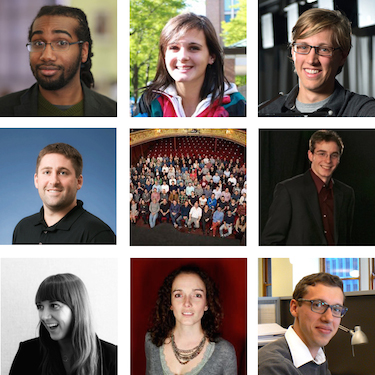
Title: Designer
Company: Thinc Design
Location: New York, NY
Why You Need to Know Him: An industrial designer with a fine arts background, Oronde Wright thinks in 3D and then draws beyond it into the dimension that gives an object meaning—how people will fit with a design and how the latter can serve the former. In speaking with him about the Thinc exhibit design projects he has contributed to in Kathmandu, Milan, and Jordan, the word “people” comes up constantly as a source of inspiration and information. “I really enjoy the part of that job where we guess what people are going to do” as they move through an exhibit, he noted. “The people are the variable, they’re the X factor.”
“Blank Surfaces Quickly Became Filled with Drawings:” A New York transplant from Jamaica, Wright landed in the Empire State as a baby and jokes that he didn’t take any interest in the change of scenery until the family moved to Brooklyn. His view was one he invented on the blank fly leafs of books, drawing anywhere that open space presented itself. Then the blank page went 3D with LEGOS, and a designer was born. “The open construction and being able to really let your imagination run wild while simply playing with blocks, that was the first instance where I realized I wanted to create things, not just recreate things.”
Art School for the Altruistic: Jump-cut to Rochester Institute of Technology (RIT), where Wright honed his strong computer modeling skills and translated drawings into objects with an objective. “I knew I wanted to do something creative, but at the same time I wanted to do things to be helpful in the world. Industrial design allowed me to create something that ideally made somebody’s life better.” He didn’t want to make beautiful, empty things. Fortunately a summer job as a recreation therapist in a nursing home revealed how “beauty was secondary” to the creative expression enabled by interaction with materials, tools and other people who are doing the same. During the pottery-making sessions he led, Wright noticed people “talking about families and life, and at the end of the discussion, everyone has something in their hands that embodies that discussion.”
Constructing a Career: Having identified his professional values from a young age, Wright was able to identify an ideal internship opportunity with Thinc Design, which became a full-time job after he graduated from RIT in 2009. There he has connected with another fulfilling aspect of those childhood blank-page filling days. “From very early on, I’ve been creating stories. All my drawings have stories behind them,” Wright observes. And if ever there was a place to tell stories, it’s through the extraordinary exhibits created by the team at Thinc. Working on the Climate + Change exhibition for the International Mountain Museum in Pokhara, Nepal, the USA Pavilion for Expo Milano 2015, and now The Jordan Museum in Ras al-‘Ayn, Jordan, the common thread has been about pulling visitors in to an engaging narrative.
Not Contained by the Rectangle of a Monitor: Thinc uses multimedia to help tell its stories, but the technology is meant to disappear. The most successful exhibits, Wright has learned, “immerse people and hide the boundaries,” with projection placing moving images on a variety of surfaces and creating pools of light around artifacts. “Projection turns a blank surface into a space, and people crowd around it,” and then that fun guesswork begins of “estimating where people are going to stand, and where to place objects.” And if the technology can’t behave as if by magic, he cautions, “If there’s a piece of AV within reach, you better make sure it’s interactive. We tried an exhibit where we had a lot of horizontal tables with no interaction, people touched it, and when it didn’t do anything, they walked away.”
Have Fun with It: Working on the Climate + Change project was satisfying from an influence standpoint, as Wright observed young people “learning about the environment—I did it, I made a small change.” Building such exhibits teaches the young designer much about how different cultures address design. In Nepal, a much more freehand approach is applied to design and construction, a process more akin to the little-kid LEGO days, trying things out and seeing how they work and building from there. “After that, I saw how stiffness can really break a project. Play really is such a key part of design.”
